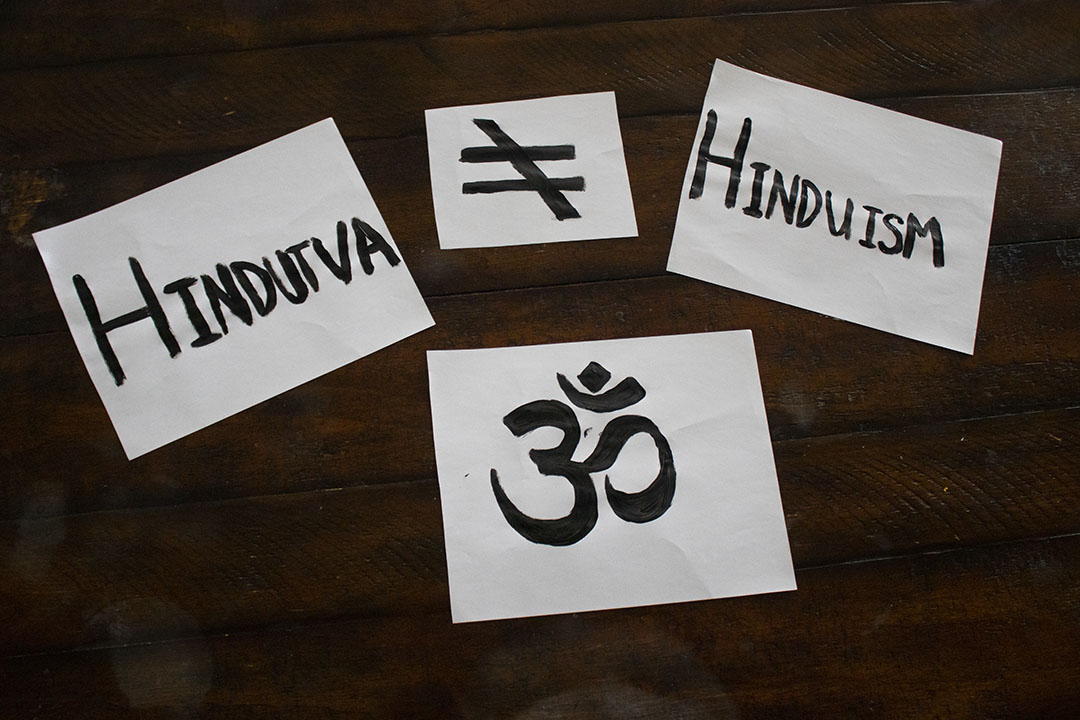Content warning: This article contains descriptions of Islamophobic violence and sexual assault.
Hindutva and Hinduism are completely separate concepts. As a Hindu myself, I thought that this distinction was as clear as separating Islam from Islamist extremism, or Judaism from Zionism.
However, protestors of UTM’s recent Dismantling Hindutva Conference claimed that the conference was “anti-Hindu.” It is ironic that the protestors, who were likely devout Hindus themselves, could not tell the difference. Their hostility was misplaced.
Hinduism — the oldest existing religion in the world — is practised by 900 million people, the vast majority of which live in India, which is also known as ‘Hindustan’ or the land of the Hindus. Hindutva, on the other hand, is an extreme right-wing Hindu ideology founded by Vinayak Damodar Savarkar in his 1923 book, Hindutva: Who is a Hindu?
Depending on who you ask, Hindutva is either the purest form of Hinduism or its estranged, fascist great-grandchild. Frankly, I see Hindutva as the latter. By far the most dangerous implication of Hindutva is that it brands India as an exclusively Hindu nation when, in actuality — even constitutionally — it is not.
Article 25 of the Constitution of India guarantees “the freedom of conscience, the freedom to profess, practice and propagate religion to all citizens.” While the word ‘secular’ — which would indicate a clear separation of religion from state — was not specifically included in India’s original constitution, a 1976 amendment to it identified India as a “sovereign socialist secular democratic republic.”
When India became independent, it was finally freed from a Christian British empire and, before that, an empire run by the Muslim Mughals. This meant for the first time in nearly 800 years, Hinduism could flourish and be celebrated freely in all of India.
The period of Mughal rule is a standard talking point for proponents of Hindutva in their constant antagonization against Muslims. In fact, in his book, Savarkar cited atrocities committed during the Mughal rule in India, writing that he would have liked the Hindu Maratha army to have exacted revenge by killing Muslim civilians, destroying mosques, and raping Muslim women.
Sadly, these ideas bear striking parallels to the actions of Hindu extremists today. Perplexingly, they utilize the historical behaviour of Mughal nobility — events from before India was even formed as a country — to justify their actions against present-day lower-class Muslim civilians. Moreover, believers in Hindutva believe that India’s increased Muslim population throughout its history was solely due to forced conversions by Muslim Mughal rulers. According to their reasoning, because the ancestors of Indian Muslims were converted against their will, they should convert back to Hinduism.
However, historical evidence suggests that most Indians converted to Islam gradually and voluntarily. It had more to do with how rivers flowed, as Muslims migrated eastward to claim the benefits of irrigation. In short, the conversion of Indians to Islam was anything but the massive tsunami of forced conversion that Hindu nationalists claim it was.
The main reason why Hindutva is being so widely covered in recent times is that it has infiltrated the seats of the Indian Parliament through the Bharatiya Janata Party (BJP) led by the current prime minister of India, Narendra Modi. The BJP was initially a branch of Rashtriya Swayamsevak Sangh (RSS) — a right-wing Hindu nationalist group that took Hindutva as its gospel.
While some members of the BJP have distanced themselves from the latter organization, the RSS still generally endorses the BJP. Before attaining the most powerful position in the country, Modi allowed anti-Muslim riots to continue in his home state of Gujarat, leading to the deaths of 1,000 Indians. The riots were led by none other than his fellow Hindu extremists.
Modi’s Hindu nationalist government is attempting to shake the secular roots of India to their core through a host of new legislation. The most pertinent example of this would be the Citizenship Amendment Act, the first-ever proposed Indian legislation that exclusively discriminates based on religion. The act sets forth a scheme in which Hindu, Buddhist, Parsi, Christian, Sikh, and Jain immigrants to India would be granted a fast track to citizenship where they would be naturalized after six years. However, all other immigrants would take 11 years to be naturalized.
The clear exclusion of Muslim immigrants from the proposed amendment is what triggered protests in December 2019. I vividly remember the news playing and replaying images of disgusted Indians of all faiths, chanting, singing, and displaying poems in all Indian languages. The mesmerizing images of unity displayed in front of me made me realize that many Indians are willing to protect what makes us beautiful: our immense cultural diversity.
However, this valuable national trait is perceived as a threat by supporters of Hindutva. The disdain that believers of Hindutva show for the religious diversity within India is perplexing — especially, given that many scholars and experts of Hinduism acknowledge that it would be impossible to invent a single true form of religion. Rather, the discovery of god occurs in a multitude of ways, and many religions may be connected to the same otherworldly power. Therefore, advocating for Hindu supremacy may go against the ideals of the religion itself.
Confusing Hindutva — a concept that is contradictory to the constitutional values of India — with Hinduism undermines the social and political fabrics of its birthplace. Therefore, proud Indians, especially Hindu Indians, must remind themselves and each other as often as possible: Hinduism is not Hindutva.
Shiv Bailur is a first-year social sciences student attending University College.


